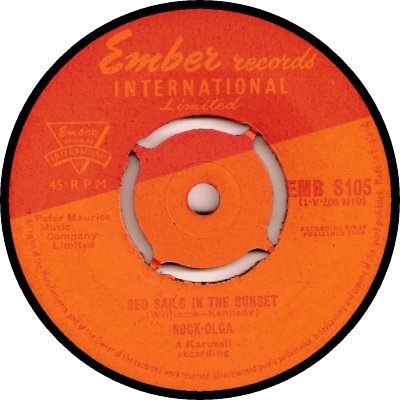

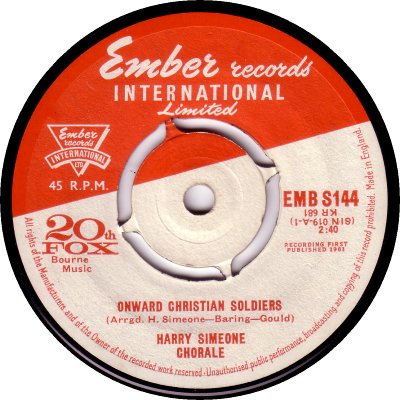

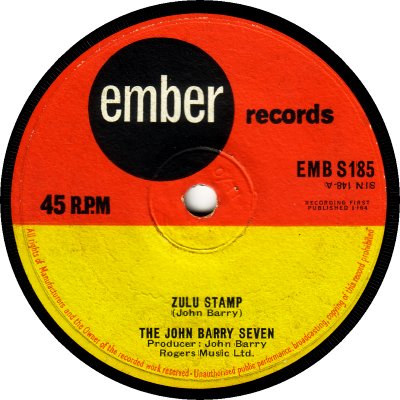
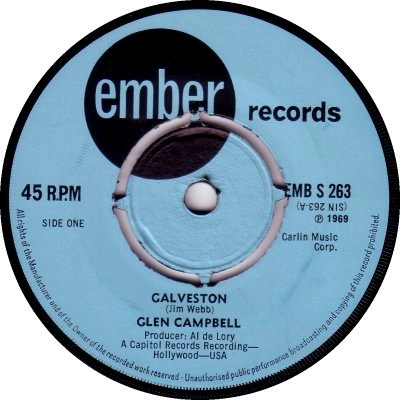
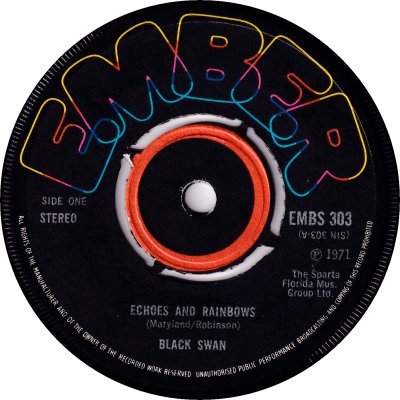
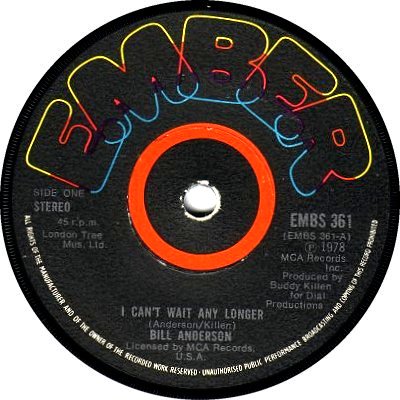


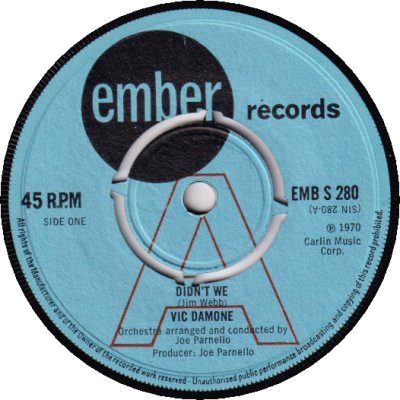
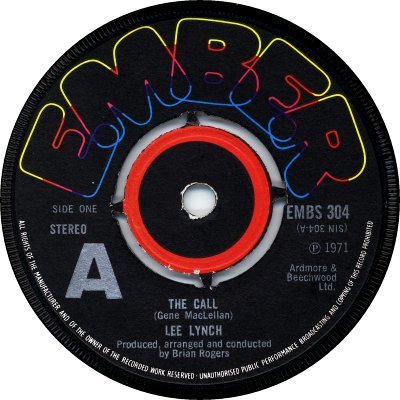
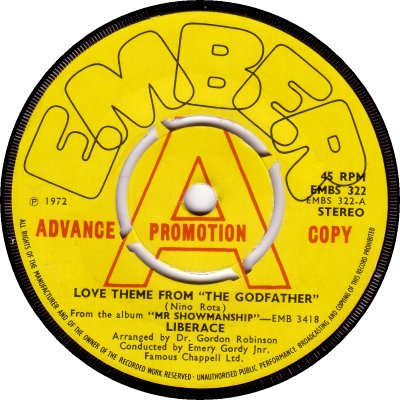
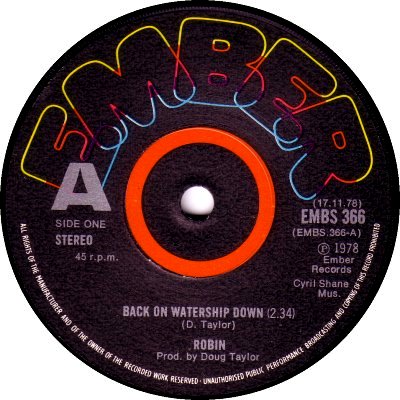
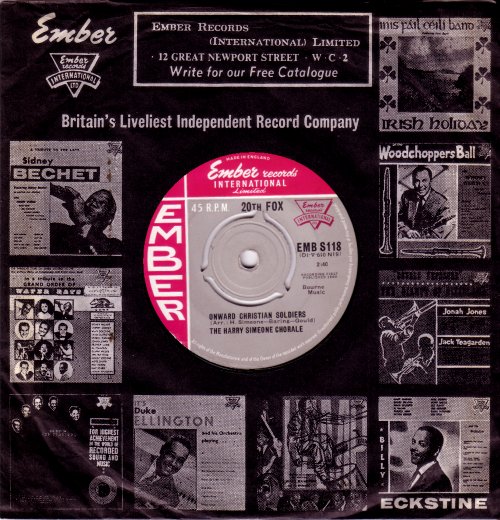


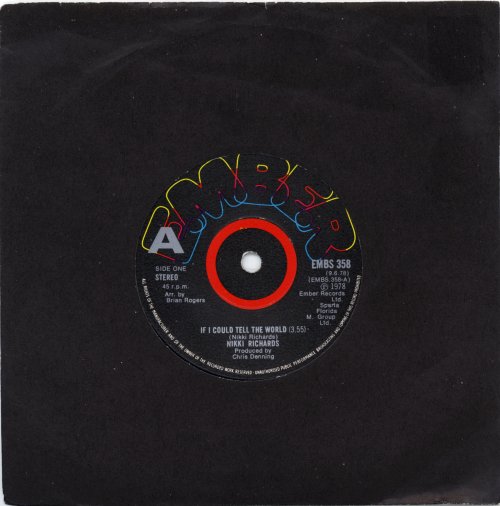
Founded in 1960 by Jeffrey Kruger (alternatively 'Krueger'), Ember was one of the first independent record companies in this country. Its roots lay in Ember Records International, a company set up by Al Silver of the American firm Ember Records Incorporated in association with Kruger, who looked after Silver's publishing interests here. Shortly afterwards Silver did a deal with Rank to represent his product, leaving Kruger with the shell of the company ('Music Week', 1st February 1975). Kruger rose to the challenge and launched the Ember Records International label in the summer of 1960. It enjoyed an encouraging start when it had minor hits with its first two singles, Jan & Kjeld's version of 'Banjo Boy' b/w 'Don't Raise A Storm' (EMBS-101; 6/60), to which its associated publishing company Florida Music (later Sparta Florida) held widespread publishing rights, and 'The Madison' b/w 'Jump Over' by Ray Ellington (EMBS-102; 7/60). 'Billboard' of the 26th of June 1961 carried a feature celebrating Ember's first anniversary. By then Kruger had acquired the rights to material from 20th Century-Fox and to selected product from two other American labels, King and Bilbao; he marked the anniversary by adding the Rondo catalogue to that list, via an agreement with Rank Records Inc., which gave Ember access to records by the likes of Frankie Laine, Kay Starr, Duke Ellington and Sarah Vaughan. According to the article Ember had issued thirty-one singles, five EPs and twenty-three LPs in its first year, and its best seller so far had been 'Onward Christian Soldiers' b/w 'The Little Drummer Boy' by the Harry Simeone Chorale (EMBS-118; 12/60), both sides of which had been out previously on Top Rank - 'Little Drummer Boy' had reached the No.13 spot in January 1959 (JAR-101). Ember had started releasing discs made by publishers - a Grant Tracy single from Abersoch and a Tommy Sanderson one from Francis, Day & Hunter were mentioned - and it had ties with three manufacturing plants, which would enable it to produce 100,000 records made per week if the occasion arose.
The company took a step forward in the Spring of 1963 when it signed a distribution agreement with Selecta ('BB', 11th May 1963), giving its records nationwide availability. Until that time it seems to have relied on small independents; according to 'BB' of the 22nd of September of that year there were ten of them. 'BB' of the 24th of August reported that Kruger and new A&R chief John Barry - the John Barry - had taken advantage of the increased opportunities offered by Selecta by giving Ember a new image, signing and introducing 'many new artists'. In addition it intended to adapt the novel approach of supplying its distributors with records before any released date had been set, and fixing a date only when a culmination of TV and radio plugs had been organized. How long this approach lasted, if it was adopted at all, remains to be discovered. There were a couple more minor hits in the second half of that year: Chad Stuart & Jeremy Clyde took 'Yesterday's Gone' b/w 'Lemon Tree' to the No.37 position (EMBS-180; 8/63), and with the aid of his Seven and Orchestra John Barry got to No.49 with a pairing of James Bond-related sides, 'From Russia With Love' and '007' (EMBS-180; 11/63).
Singles chart hits remained hard to come by, but Ember carved out a niche for itself as a budget-priced LP label. Its determined and adventurous pursuit of licensing deals enabled it to release collections by such famous names as Glenn Miller, Al Martino, Charles Aznavour and Woody Herman, and it claimed a reasonable slice of the Jazz market. 'BB' of the 24th of April 1965 reported that 20% of the company's sales were down to Jazz LPs, and said that while a figure of 1,000 sales per year had been considered good a year ago the current figure would be expected to be four times as many. EMI was added to Ember's list of distributors in January 1965 ('BB', 23rd January), but the agreement only lasted for some fifteen months: following a general rearrangement of distribution outlets by the major companies Ember chose to go with Selecta ('BB', 9th April 1966).
Ember launched a couple of new labels in 1967, CBM for Soul / Reggae, and Speciality, but they proved short-lived - CBM departed that same year, and Speciality failed to see the end of 1968. 'BB' of the 18th of February noted that Ember had signed a deal with Capitol for the release of four Ember LPs in the USA and had also extended its deal with the American label Crown, which enabled it to add records by Stan Getz B.B. King, Etta James and Ike Turner to its catalogue; it also had deals with US Decca and Roulette. Ember was described as a 'low-priced independent' and Kruger was quoted as saying that overseas deals had contributed substantially to his company's turnover. Kruger went to great lengths both to acquire product from abroad and to place Ember material: in November 1968 a mutual distribution agreement with French label AZ led to the appearance of the joint-label Ember-AZ in that country ('BB', 23rd November), and a few weeks later a one-way agreement led to the launch of the Ember-Ariola label in Germany ('BB', 14th Deecember). Several of the company's LPs had already been placed with Star Records of South Africa ('BB', 16th March 1968). That same year John Barry joined the board as company chairman. 'BB' of the 3rd of February, reporting on the appointment, added that he would also be the executive producer for Ember's major recording activities.
In 1969 Ember finally found itself with a Top 10 record. Its deal with Capitol gave it the rights to release in the UK any of that company's material which the UK branch of Capitol didn't want. When UK Capitol showed no interest in singer / songwriter Glen Campbell Ember snapped his records up, and after four unsuccessful singles his fifth, 'Wichita Lineman' b/w 'Back In The Race' (EMBS-261; 1/69) gave the company its first big Singles Chart success, peaking at No.7. The follow-up, 'Galveston' b/w 'Every Time I Itch I End Up Scratchin' You' (EMBS-263; 5/69) got to No.14, but by that time Capitol had been alerted to Campbell's potential and they hung on to his subsequent recordings. Sadly, that was to be the end of Ember's flirtation with the Charts.
Kruger kept plugging away, on several fronts. He formed Ember Film Distributors in 1970 ('BB', 19th December), and in that same year signed agreements with the Trans World Corporation of Canada and with Nippon Columbia of Japan to have Ember records put out in those countries ('BB', 26th September). According to the 'BB' article Kruger was preparing for Ember to enter the American market, but 'BB' of the 24th of February 1971 reported that he had shelved plans for the launch because of 'current conditions in the US market'; he did however intend to continue making licensing deals on a record-by-record basis. His Sparta Florida Music publishing company continued to do good business, and among his other companies was the agency Nucleus Entertainments; in 1972 the latter was replaced by Ember Concert Attractions, which specialized in "concerts, club engagements and other appearances by major artists" ('BB', 12th August). Despite all these efforts the strains of operating as an independent company were beginning to take their toll, and in 1972 'Record Retailer' of the 15th of January broke the news that Ember had been engaged in talks with Pye; if those talks were successful a licensing deal was expected to be in place by the 1st of April. In the event an agreement was reached quickly, and 'RR' of the 29th of January was able to state that a five-year licensing deal had been signed, covering manufacture, distribution, sales and promotion. 'BB' of the 5th of February quoted Kruger as saying that the strength of an alliance with a major had become imperative.
In its new role as a licensed label Ember continued to make deals and to put out a variety of sometimes interesting but rarely popular singles. It made a brief and unsuccessful appearance in the USA in 1974: 'MW' of the 23rd of March reported that it would be linking up with Paramount to form the Paramount-Ember label. 'MW' of the 3rd August was able to state that the new label had been launched, but within weeks Paramount was sold to ABC, bringing an end to the arrangement. A development which appeared less than significant at the time but which later proved to have been important took place in February 1975 when Kruger-owned company outside the Ember group launched the Bulldog label (q.v.) through President ('MW', 22nd February). In 1977 a licensing agreement with Stephen Metz's Bareback Records led to the Bareback label (q.v.) making a brief appearance here, and there was a one-off deal with Jonathan King which resulted in a single by Sean, 'Sweet Surrender' b/w 'Song For Chris' (EMBS-350; 3/77). The following year, nods to current trends produced a Disco version of the theme to 'Close Encounters Of The Third Kind' b/w 'The Other Side' by The Visitors (EMBS-256; 2/78), 'Skateboard Hero (Parts 1 and 2)' by Lucy Lastic (EMBS- 357; 3/78), and finally a 'punk' rendering of 'White Christmas' b/w 'Rich Man' by Slush (EMBS-367; 12/78), but the end was drawing near. 'MW' of the 19th of May 1979 bore the sad news that the Ember Leisure Group of companies, including Ember Records, had closed down, and there was to be a meeting of creditors. Ember was to continue as a production company, 'The Ember Organization', signing artists and placing their records with other companies. The final word went to Jeff Kruger, who had fought a gallant battle for eighteen years. "We have reached a point where an independent cannot compete. ... The era of the superpowers is upon us," he was quoted as saying. He wasn't wrong.
All was not lost, however. Kruger still had the Bulldog label. Since its launch it had served mainly as a vehicle for low-priced reissues of Blues and R&B albums, though it had also put out a reasonable number of singles associated with his Sparta Florida Music publishing company. 'MW' of the 7th of July 1979 observed that Bulldog was still a going concern, as part of Kruger's Visual & Audio Leisure firm, which hadn't been affected by the closure of Ember. Then a couple of months later 'MW' of the 15th of September announced that Kruger had launched a new company, TKO - 'The Kruger Organization', and that as part of the comeback the Bulldog label was to be reactivated. 'BB' of the 25th of October added that the Florida Music publishing company was to continue, as were agency and management activities and concert promotion activities. Bulldog more or less took on Ember's old main role as a repackager of licensed material, and it continued to perform that function into the '80s and beyond the scope of this site.
Ember used a variety of label designs. An initial red-on-orange one (1) served for the first five releases, after which, in October 1960, the orange was replaced by gold (2), presumably for better legibility. The same design in red on white labels was used for EMBSes 144, 145 and 146, from December 1961 to February 1962 (3), after which point a new the grey design was introduced. The example shown is of a reissue (4). In November 1963 the 'International' part of the name was dropped and the grey label was succeeded by a red-and-yellow-halves one (5) which had been given a short run between August and September with EMBSes 177, 178 and 179. EMBS-175, a saucy single by Miss X, 'Christine' b/w 'S-E-X-' had a white label with the ember logo in black. July 1968 saw the halves disappear and the colour become light blue (6). In November 1970 a new, black, design was introduced (7) which was practically unaffected by the move to Pye (8) and served till the end.
With regard to promo markings, there appear to have been none until around November 1965, at which point a hollow green 'A' was overprinted on the red-and-yellow-label (9). The 'A' turned silver with the change to light-blue labels (10), and then turned red in April 1970 with EMBS-278 (11). Promos on the black label were marked by a small silver 'A' (12). After the move to Pye yellow demo labels were used, as was generally the case for members of the Pye family (13). The small silver 'A's made a return in the summer of 1977, and stayed until the finish (14). Through all the changes of label design the catalogue numbering remained constant: it started started at EMBS-100 and ended at EMBS-370. There was also an occasional JBS-700 'Juke Box Series', and a more prolific EMB / EMBEP-4500 one for EPs. In its days as an independent Ember seems to have had recourse to a number of different manufacturers, including British Homophone. As far as the 70s are concerned, pressing appears to have been done by Orlake and distribution by Selecta until February 1972, when Pye took over both functions. The catalogue series remained unaltered at the changeover, but the prefix of the matrix numbers changed from 'SIN' (7) to 'EMBS' (8) . Some product with Ember numbers appeared on the Bareback label (q.v.); it was licensed from the American company of that name. Ember singles from the late '70s came in plain black sleeves (18). The discography that follows only covers the 1970s. Thanks to Recordman 46 of the 45Cat site for the use of the first scan. The tenth comes by courtesy of Nicholas Hough.
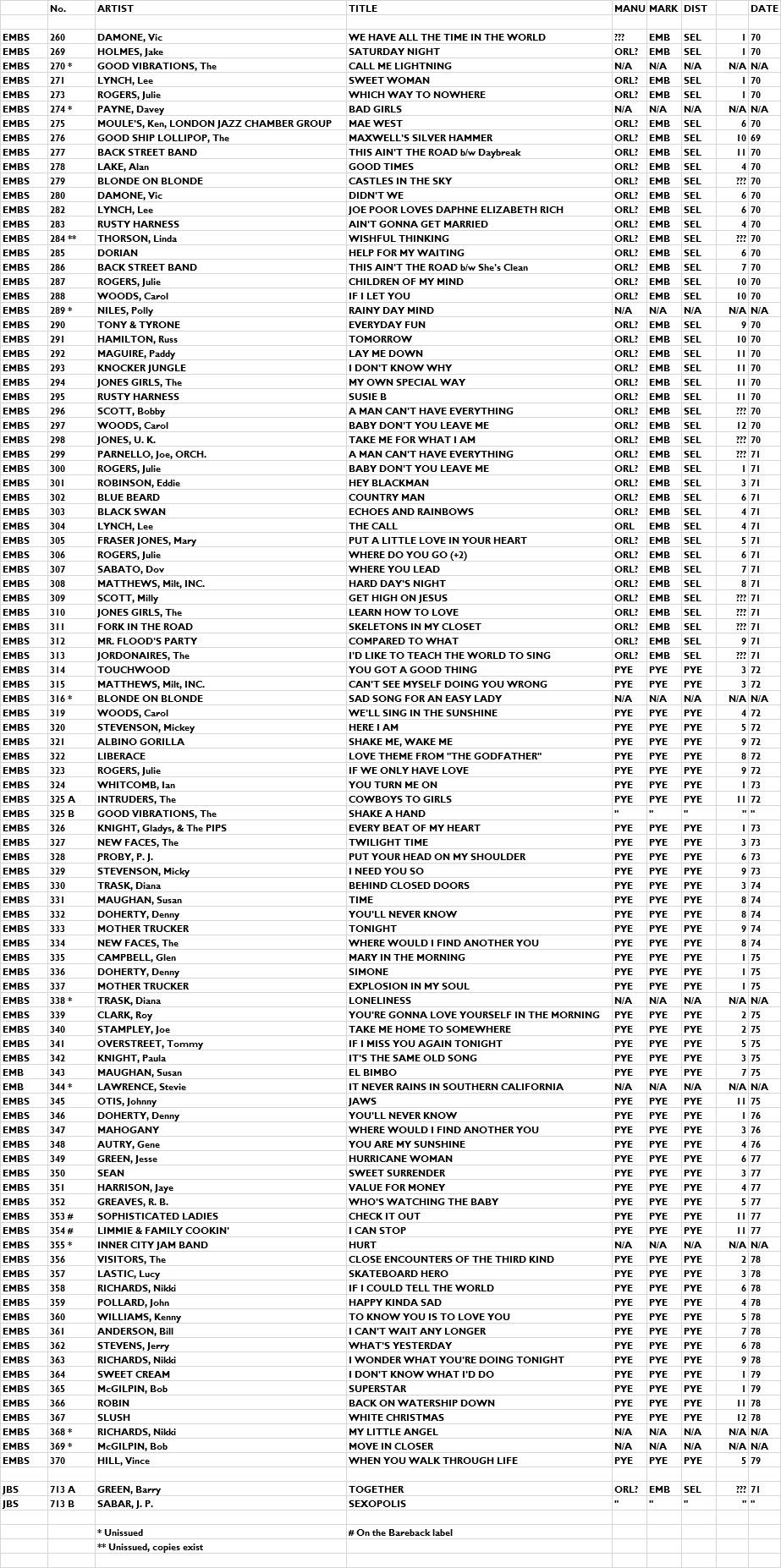


Copyright 2006 Robert Lyons.

